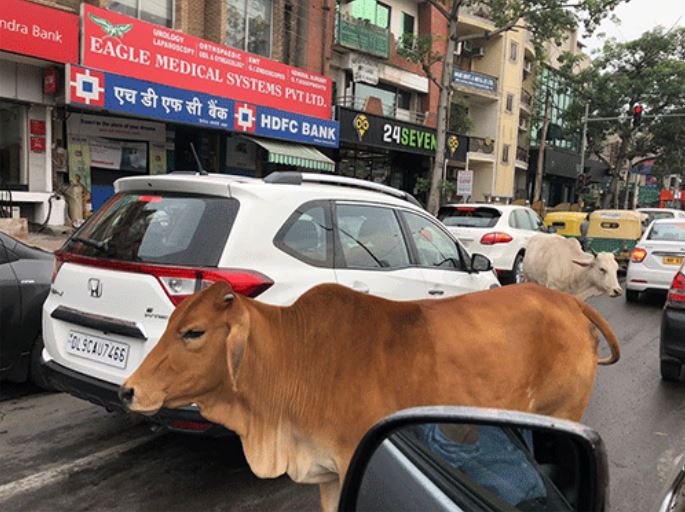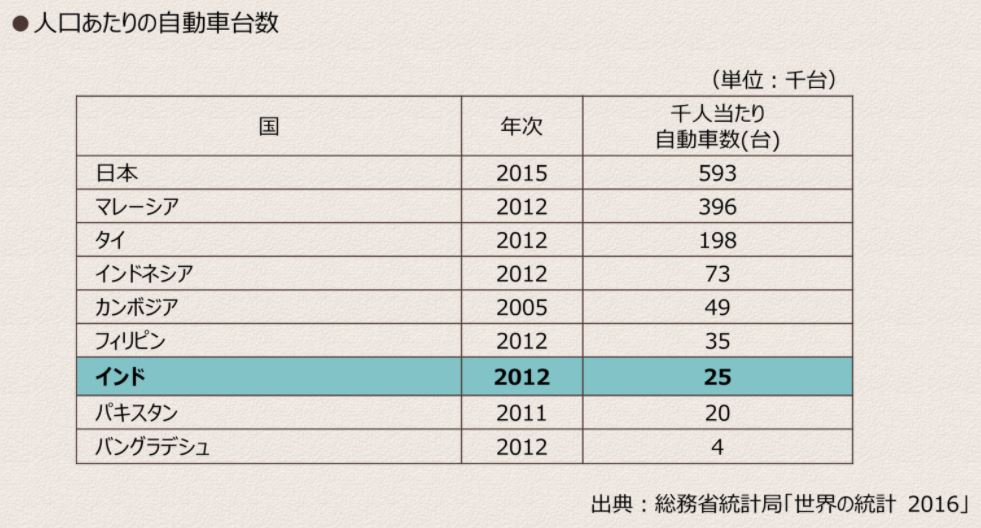<Report from overseas office> [India] Mobility in India
- Release date: Sep 25, 2019
- 13638 Views

Ridesharing in India and Consumer Attitudes
What do you think of when you hear about the Indian automobile market? If you are in the automobile industry, you probably know that Maruti Suzuki accounts for about 50% of the market share. If you have actually visited India, you may have imagined the heavy traffic jams, cows hanging out on the streets, or the incessant honking of horns. Also, since EVs in India have been in the news a lot in Japan lately, many people may be interested in them.
Cows strutting through the traffic (Photo by the author)
India's GDP per capita is about 2,000 USD, which is about 1/20th of Japan's. Among the emerging countries in Asia, it is higher than Bangladesh and Cambodia (about 1,500 USD), but lower than Vietnam (about 2,500 USD). It is said that cars usually do not start to become popular until the GDP per capita exceeds 3,000 USD, so for the average person, a private car is still a high price to pay. In fact, statistics on the number of cars per capita show that India has fewer cars than the countries of ASEAN. However, in India, where the gap between the rich and the poor is huge, the GDP per capita in the capital city of Delhi is said to exceed 5,000 USD, and private cars are beginning to penetrate the middle class. 
Traffic Conditions in India
Before I introduce the details of the car-dispatching app service, I would like to briefly introduce the transportation situation in Delhi, where I live. In recent years, the development of the railroad network (metro) in Delhi has been progressing at a rapid pace, and several new lines have opened in the three years that I have been there. Both the stations and the trains are very clean and comfortable, with air-conditioning that you would not expect in India. The buses also cover the entire city. Auto rickshaws and rickshaws are the most common mode of transportation for the common people of Delhi. Auto rickshaws are three-wheeled mini-cars that can be used throughout the city in the same way as cabs. (If you are familiar with Thailand, you can think of it as a tuk-tuk. Rickshaws, which are bicycles with seats for two or three people attached to the back, are widely used as "last mile" transportation.As for the commuting conditions of the local staff at Intage India, where I work, some of the manager class commute by private car (about 10%), half of the male staff commute by 100-200cc small motorcycles, and the other half of the male and female staff commute by bus or metro. The other half of the male and female staff commute by bus or metro.

From left to right: Metro, auto rickshaw, rickshaw (photo by the author)
Positioning of car-hailing apps
I would like to take a closer look at car rental apps. The first major difference is that in India, the service is provided as a simple car-dispatch service, while in other countries it is called "ride-sharing". The cars used for the service are not privately owned, but are required to have a commercial vehicle license plate (yellow).●Fierce battle: OLA vs UBER
The battle for ride-sharing continues all over the world, and in Southeast Asia, the battle seems to have already been decided, but in India, UBER and the local OLA are still in a fierce battle. In India, however, UBER and OLA are still battling it out fiercely. Both companies are launching promotions one after another, to the extent that the screens of cell phones are sometimes filled with push notifications of promotions from both companies. My impression is that UBER has a slight edge in terms of price and number of registered drivers, while OLA is characterized by services localized for the Indian market, such as the ability to request auto rickshaws, in-car monitors to provide entertainment, and free WIFI. I myself often choose UBER because of its price and short arrival time. In addition to services for consumers, UBER is also competing fiercely to secure drivers by offering favorable car loans to prospective new drivers in cooperation with car manufacturers.Are young people moving away from cars?
Currently, the global trend is said to be shifting from ownership to sharing, especially among young people.Since India has the largest population of digital natives in the world, the impact of this trend on the future automobile market will be particularly significant.
In fact, when I talk to local residents and our young employees, I often hear them say that owning a car is not a necessity.
They say, "Why don't we just use OLA/UBER? Many say they do not want to spend time on maintenance.
Many people cite traveling and eating out as ways to spend their holidays, and it is clear from the people, information, and services I come in contact with on a daily basis in India that consumption priorities are shifting from "ownership" of assets to "experiences" such as travel.
In India, too, lifestyles of other countries are coming in real time through social media.
There is no doubt that the values and lifestyles of young people are changing rapidly.
As a clear example of this, I would like to introduce a striking statement by a trend watcher.
He said that the aspirations of Indians, especially young people, are shifting from "Bollywood stars" to "Hollywood stars.
This is another example of the change in values due to the ease of following foreign celebrities on social networking sites and easy access to the latest information.
(It should be noted, however, that for India, the object of admiration is the West, which is quite different from East and Southeast Asia, where Japan may be the object of admiration.)
The Automobile for Indians
Changes in the sei-katsu-sha are definitely taking place. However, from the point of view of a researcher watching the market locally, I believe that attitudes toward car ownership will not change that quickly. One of the reasons is that for many Indians, owning a car is still a kind of "status symbol". Of course, other countries have this aspect of cars as well, but it seems to be more important to Indians than to other countries. One of the key words in understanding Indian people is "show-off," which is used to mean "show-off" or "vain. For Indians, it is important to stand out in front of others and make oneself look big, and automobiles are a straightforward way to express this.Another perspective is the influence of the value of family. When interviewing car owners, even those who are unmarried and buying a car for the first time, they often emphasize "family use" or ask their families for their opinions. It is also common for families to visit relatives together on weekends. Although the purchase of a private car is strongly related to life stage, India still has a low unmarried rate compared to developed countries, and many people live with large families even after marriage, so I believe that the role of the car as a tool for going out with the whole family will remain.
Of course, there is no doubt that the above ideas and lifestyles are exactly the ones that will change rapidly in the future. But in closing, I would like to emphasize one more important perspective. But I would like to emphasize one more important point: only a small part of the huge population of India is in line with the latest trends. Living here, I see a rapidly changing India, but at the same time, I have many more opportunities to experience an unchanging India. That's why I don't think that attitudes toward automobiles will change so dramatically.
Now, how will I feel when I look back on this article in five or ten years? Will I think that my viewpoint as a researcher was correct, or...?
-

Author profile
(Mr.) Sumito Ito
He is one of Intage's foremost specialists in Asian research. He has been stationed in Delhi for four years now. Prior to his assignment in India, he spent four and a half years in Bangkok supporting the marketing activities of many clients in ASEAN countries. He believes in gaining information by experiencing local life himself, both in public and private life.
-

Editor profile
Intage Inc.
-
 Global Market Surfer
Global Market Surfer CLP
CLP